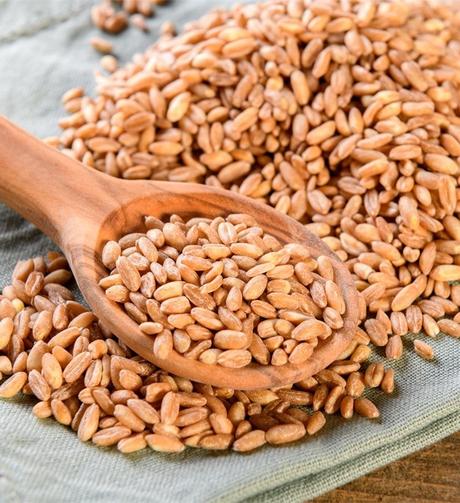
Farro is an ancient whole grain that refers to three types of wheat - einkorn, spelt, and emmer. It has a nutty flavor, a chewy texture, and is high in protein, fiber, and magnesium. It's a staple ingredient used to make soups and salads, although it can be added to pilafs and dessert dishes as well.
Farro, despite being incredibly versatile, is not gluten-free, so it won't be a great fit for those with specific dietary and allergic needs. But don't worry, you can use these farro substitutes to produce a dish that's healthy and has a similar flavor and texture.
1. Barley
Barley is an excellent source of nutrients like fiber, essential vitamins, and minerals. But, since refining barley loses most of this nutrition, it's recommended you use the unrefined variety whenever possible. Barley has a nutty flavor and chewy texture, and it is similar in size to farro, making it one of the best farro substitutes you can use for a healthy diet.
You can use the slightly nutty and sweet barley instead of farro in soups, salads, stir-fries, casseroles, and porridges without changing the recipe's final outcome. Keep in mind that it takes less time to cook, so you will need to adjust the cooking period. Barley also releases a lot of starch during cooking, so cook it separately and then add it to soups to avoid thickening them.
2. Freekeh
Freekeh, occasionally known as farik or frik, is an ancient grain made with green kernels from unripe durum wheat. The kernels have a smoky taste that is distinct from the nuttiness of farro, but they do have a similar chewy texture. While freekeh is not gluten-free, it has a lower gluten content than most wheat varieties.
The wonderful flavor and texture of freekeh will elevate any dish that calls for farro, and its hearty smokiness works exceptionally well in savory dishes like soups and stews. Freekeh takes 45-50 minutes to cook, which is admittedly too long even on days you have time to spare. Luckily, you can avoid the slow-cook process by purchasing cracked freekeh grains.
3. Kasha
Kasha is a cereal made with roasted, soaked, and cooked buckwheat groats. It has a nutty flavor similar to farro but with a firm yet gummy consistency. Kasha is rich in various soluble fibers and antioxidants and does not contain any gluten, so it is the best option for someone with celiac disease or gluten sensitivity.
You can use kasha in various dishes that call for farro. But keep in mind that it tends to become mushy and lose its wonderful texture when overcooked. To avoid that, use only one and a half cups of liquid for every cup of kasha. And because it cooks quicker than rice, adjust the cooking time accordingly.
4. Quinoa
Quinoa is a great source of protein, minerals, vitamin E, fiber, and all essential amino acids. The nutrient profile of this superfood makes it the best substitute for farro. It's also gluten-free, low in calories, and is a great plant-based protein source for vegan and vegetarian diets.
Quinoa is a highly versatile ingredient that can replace farro in most dishes. It will lend itself beautifully to soups, pilafs, breakfast bowls, and even baked goods and burgers. But, keep in mind that quinoa cooks faster than most substitutes on this list, so you will have to adjust the recipe's cook time accordingly.
5. Rye Berries
Rye berries are hulled whole grains from the rye plant. Once cooked, they develop a firm texture and a mild nutty flavor as their grayish hue transforms into a deep brown. They also have a lower glycemic index and contain less gluten than farro, making them a suitable substitute for those with mild gluten sensitivity and type 2 diabetes.
Rye berries are excellent in salads and soups and also work exceptionally well in pilafs and risotto. They are also great to pair with other ingredients, so they can be used to make a flavor-packed breakfast cereal as well. The only catch is that rye berries tend to add slightly sweet and sour notes to the dish, which may not be palatable for all.
6. Spelt Berries
Spelt berries are kernels from spelt, an ancient wheat grain. They develop a wonderful nutty flavor when cooked, similar to farro, and are an excellent source of fiber. Spelt berries have a tougher texture than farro but work as a good alternative.
The tough texture and sweet, mild, and nutty flavor of spelt berries are wonderful in salads and breakfast bowls. It is also a great ingredient to add to soups, stews, and other rice-based dishes as well as baked goods. However, since spelt berries are derived from wheat, they are not gluten-free and won't be unsuitable for some diets.
7. Wheat Berries
Wheat berries are kernels from the wheat plant. They have a brownish-red color with a mild flavor. But, when cooked, they develop an earthy, nutty taste like farro, only with a much lighter and chewy texture. They're a great source of fiber and proteins and are perfect to add to vegan and vegetarian diets.
Wheat berries are incredibly versatile and take on some of the flavors of the other ingredients when cooked. So, make sure you check the other ingredients used in your recipe to ensure balanced flavors. Weather berries are great for replacing farro in savory dishes like soups and chili. However, they take longer to cook and are not gluten-free, so wheat berries won't be appropriate for those with gluten sensitivity.
